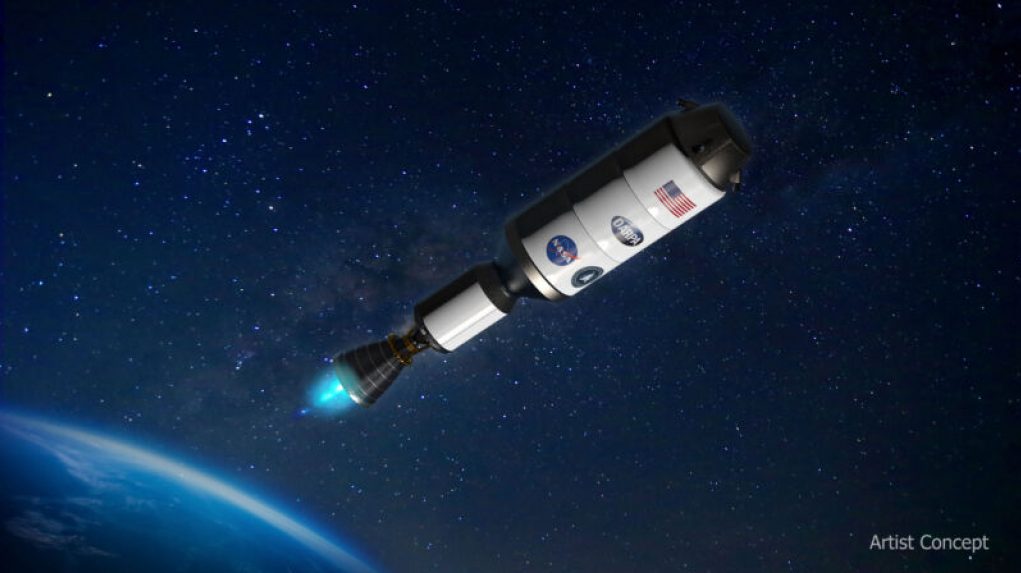Get ready for an exciting space milestone! In just four years, a nuclear-powered rocket engine will launch into space for the very first time. While the rocket itself will be conventional, the payload it carries will be revolutionary.
NASA has announced a groundbreaking partnership with the US Department of Defense to launch a nuclear-powered rocket engine into space by 2027. With an investment of approximately $300 million, NASA aims to develop a next-generation propulsion system for in-space transportation.
“This system will take us to Mars,” says Anthony Calomino, the lead engineer at NASA’s space nuclear propulsion technology program. “This test will provide us with the foundation we need.”
Revolutionizing Space Travel
Traditional chemical propulsion has its limitations when it comes to exploring the Solar System. It’s inefficient and requires massive amounts of fuel and oxidizer to reach distant destinations like Mars. To truly become a spacefaring species, we need a better solution.
Decades ago, German engineer Wernher von Braun recognized the potential of nuclear thermal propulsion. However, the technology was put on hold until 2020 when the US Defense Advanced Research Projects Agency expressed interest in testing a flyable nuclear thermal propulsion system. This led to the creation of the Demonstration Rocket for Agile Cislunar Operations (DRACO) program.
NASA joined forces with DRACO, aiming to develop similar technology for a Mars mission. Many scientists and engineers believe that nuclear propulsion is the key to sustainable Mars exploration.
The Path Forward
Lockheed Martin has been selected as the primary contractor to assemble the experimental nuclear thermal reactor vehicle (X-NTRV) and its engine. BWX Technologies will partner with Lockheed Martin to develop the nuclear reactor and fabricate the fuel needed to power it.
The total value of the contract is $499 million, according to Tabitha Dodson, program manager at DARPA. NASA will lead the development of the nuclear engine, while DARPA will oversee regulatory requirements and mission operations.
The nuclear reactor will launch in a “cold” mode for safety reasons and will only be activated once it reaches a high orbit. The final orbit is yet to be determined, but it will likely be hundreds of kilometers above Earth’s surface to ensure the vehicle’s reentry occurs long after any nuclear reactions.
The nuclear-powered vehicle will be launched within the payload fairing of a Falcon 9 or Vulcan rocket. Once in orbit, the reactor will be turned on, rapidly heating the liquid hydrogen propellant. However, there are still unknowns about the performance of the reactor and its fuel in zero gravity.
“It’s important to remember that this is a demonstration engine,” explains Dodson. “Further engine development may be necessary to achieve the perfect operational engine.”
Advancements in Propellant Management
Aside from the nuclear engine, this mission also aims to make advancements in managing liquid hydrogen propellant in space. Until now, liquid hydrogen could only be stored for a few days due to its extremely low boiling point. However, this mission will attempt to store liquid hydrogen in its ultra-cold state for a couple of months, allowing for multiple tests of the nuclear thermal engine.
Once the propellant runs out, the engine will cease to operate. However, the spacecraft may still be able to communicate with mission controllers on the ground. There is potential for the mission to be extended if robotic refueling becomes possible.
By the end of this groundbreaking mission, NASA and DARPA may have gathered enough knowledge to develop an operational engine for future space exploration.
The United States government has taken a significant step into the future of space exploration and development. The Department of Energy (DOE) has announced plans to collaborate with the US Air Force (USAF) and the US Space Force (USSF) to develop and test space-based nuclear propulsion technologies.
The endeavor is expected to help further two important objectives related to space exploration: increasing propulsion capabilities and reducing risks associated with long-term space travel. Nuclear-thermal propulsion will revolutionize space travel as it offers significantly greater launch capabilities and a much higher thrust-to-weight ratio than standard chemical propulsion systems, enabling spacecraft to reach distant destinations in record time.
In addition, the technology offers a much safer way to explore space than current chemical propulsion systems. These systems produce large amounts of highly explosive energy sources, increasing the risk of explosion in the potential event of a catastrophic incident. Nuclear propulsion, on the other hand, is much less volatile and therefore much safer. This collaboration will represent a major milestone, as the US military will be the first to develop and test space-based nuclear propulsion systems.
The collaboration between the DOE, the USAF, and the USSF is only the beginning of the government’s plans for space-based nuclear propulsion. The initiative is expected to bring together experts from a variety of different fields. This includes scientists, engineers, and astronomers who specialize in nuclear technologies.
The goal of this endeavor is to outline the potential of the technology, identify its optimal applications, and test how well the systems work in space. To that end, the government plans to invest heavily in research and development. This is expected to eventually lead to the development of commercial nuclear-thermal propulsion systems, which could be used to power a variety of different space-based activities.
The collaboration between the US government agencies will put the country in a prime position to capitalize on the potential of nuclear-thermal propulsion technology to revolutionize space travel and exploration. As the US military is leading the development of this technology, it is safe to say that the future of space exploration looks brighter than ever.




















